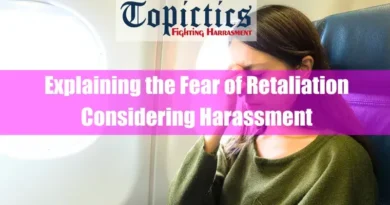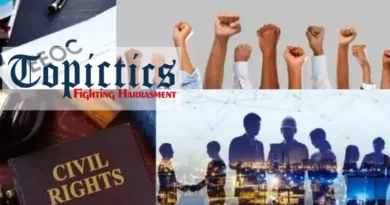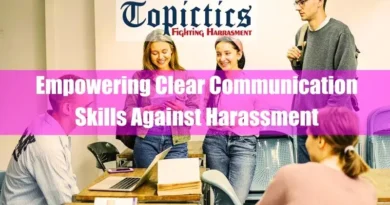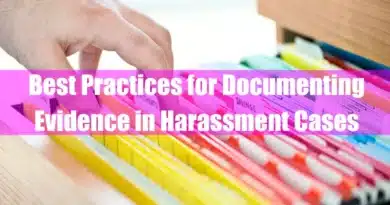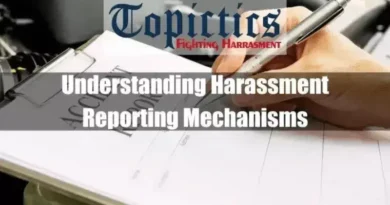An effective investigation builds trust and selects qualified investigators to ensure fairness. It then gathers information through skilled interviews and comprehensive evidence collection. This information is meticulously analyzed to form a clear picture and documented in a detailed report. Finally, the investigation determines outcomes, communicates transparently, and outlines the following steps to achieve justice and prevent future issues.
I. Building the Foundation for Effective Investigations
Harassment, in any form, casts a long shadow over workplaces, creating a hostile environment and inflicting pain on individuals. Conducting thorough and effective investigations becomes crucial in such situations to address the specific complaint, ensure fairness, uphold justice, and deter future occurrences. This article delves into the intricate world of effective harassment investigations, equipping organizations and investigators with the knowledge and tools to navigate this sensitive process with utmost professionalism and sensitivity.
Firstly, we must acknowledge the immense impact of effective investigations. They foster trust within the organization, demonstrating a commitment to creating a safe and supportive space for everyone. Furthermore, meticulous investigations ensure fair outcomes, holding individuals accountable for their actions while protecting the innocent from false accusations. Mishandled investigations, on the other hand, can have disastrous consequences, perpetuating the very issues they aim to address and eroding employee morale. This highlights the immense responsibility that organizations and investigators have to strive for excellence in every step of the investigative process.
Stay tuned for the next part, where we’ll delve into the essential building blocks of a strong investigative framework – from creating a safe and supportive environment to selecting the right investigators and taking those crucial initial steps. Remember, effective investigations are a cornerstone of a healthy workplace, and this journey begins with setting a solid foundation.
II. Building a Safe and Effective Framework for Investigations

Now that we understand the gravity of effective investigations let’s dive into the nitty-gritty of building a robust framework. Imagine this framework as a sturdy house, sheltering the investigation from bias, ensuring its integrity, and ultimately leading to a just outcome.
A. Bricks of Trust: Building a Supportive Environment
Before the investigation even begins, the foundation needs to be laid. This means creating a safe and supportive environment where employees feel comfortable reporting harassment without fear of retaliation.
Here are the key ingredients:
- Clear and Accessible Policies: Everyone should understand what constitutes harassment and how to report it. Make policies readily available and easy to comprehend.
- Multiple Reporting Channels: Offer diverse options for reporting, like anonymous hotlines, online forms, or dedicated personnel. This empowers individuals to choose their preferred method.
- Training and Awareness: Regularly train employees on recognizing and reporting harassment, fostering a culture of respect and understanding.
B. Choosing the Right Investigators: Selecting the Guardians of Fairness
Like a strong house needs skilled builders, effective investigations require qualified investigators. Here’s what to look for:
- Impartiality and Objectivity: Choose individuals without a connection to the case or parties involved. They should approach the investigation with an open mind and avoid personal biases.
- Trauma-Informed Approach: Investigators should be trained to understand the impact of harassment and conduct interviews sensitively, minimizing further harm to the complainant.
- Relevant Expertise: Look for individuals with experience conducting investigations, knowledge of relevant laws and policies, and strong interviewing skills.
- Considering Power Dynamics: It is crucial to acknowledge the potential for power imbalances in harassment cases. Someone in a position of power may be less likely to be reported or face consequences for their actions. Effective investigations consider these dynamics by ensuring a safe and confidential reporting process, employing diverse investigative teams, and remaining vigilant against potential bias throughout the investigation.
C. Laying the Groundwork: Taking the First Steps
Once a complaint is lodged, the investigation kicks off. Here’s how to ensure a smooth start:
- Prompt Acknowledgement: Respond to the complaint promptly, acknowledging its seriousness and outlining the next steps.
- Thorough Interviews: Conduct in-depth interviews with the complainant, gathering detailed information about the alleged incidents and potential witnesses. Be sensitive and ensure confidentiality.
- Evidence Preservation: Secure and preserve all relevant evidence, including emails, recordings, and witness statements. This strengthens the case and prevents tampering.
- Clear Plan and Timeline: Develop a clear investigative plan outlining the steps involved, who will be interviewed, and the expected timeline for completion.
Remember, building a strong framework is crucial for a successful investigation. By prioritizing trust, selecting the right investigators, and taking the initial steps carefully, you set the stage for a fair and comprehensive process.
Related articles:
- Clarifying Consent in Professional Environments
- Understanding Unwanted Advances
- Explaining Sexual Favors Considering Harassment
III. Conducting the Investigation

Now that the foundation is laid and investigators are on board, it’s time to delve into the heart of the matter: conducting the investigation itself. Imagine this phase as meticulously piecing together a puzzle, with each interview, document, and piece of evidence contributing to the bigger picture.
A. Mastering the Art of Interviewing: Eliciting Information with Care
Interviews are the cornerstone of any investigation, requiring skilled questioning techniques and sensitivity toward all parties involved. Here’s how to unlock valuable information:
- Open-Ended Questions: Ask questions that encourage detailed responses, avoiding leading questions that sway responses.
- Active Listening: Pay close attention to verbal and nonverbal cues, demonstrating empathy and understanding.
- Identifying Inconsistencies: Gently probe inconsistencies in narratives, seeking clarification without judgment.
- Verifying Information and Corroborating Evidence: Seek supporting evidence through documents, witness testimonies, or digital records to strengthen the case.
- Maintaining Neutrality: Avoid expressing personal opinions or beliefs, ensuring an objective and unbiased approach.
B. Gathering the Puzzle Pieces: Uncovering Evidence Beyond Interviews
Interviews paint a picture, but often, additional evidence is needed to complete the puzzle. Here’s where meticulous evidence gathering comes in:
- Document Review: Scrutinize relevant documents like emails, text messages, and internal records for potential clues or corroborating details.
- Witness Interviews: Interview potential witnesses, including bystanders who may have observed the alleged incidents. Ensure confidentiality and respect for privacy.
- Examining Physical Evidence: Analyze physical evidence like recordings, screenshots, or other tangible materials that can support or contradict claims.
- Confidentiality and Security: Treat all sensitive information with utmost confidentiality and ensure secure storage to prevent leaks or tampering.
C. Putting the Pieces Together: Analyzing and Evaluating Evidence
Once evidence is gathered, it’s time to analyze its significance and draw conclusions. This requires an objective and critical eye, separating fact from fiction.
- Assessing Credibility: Evaluate the credibility of witnesses and evidence, considering potential biases, inconsistencies, and corroboration.
- Identifying Themes and Patterns: Look for recurring themes or patterns of behavior across interviews and evidence, painting a broader picture of the situation.
- Context and Workplace Dynamics: Consider the context in which the alleged incidents occurred, including workplace dynamics, power imbalances, and cultural norms.
- Avoiding Assumptions and Preconceived Notions: Resist jumping to conclusions and maintain an open mind throughout the evaluation process.
- Avoiding Confirmation Bias: Resist the urge to focus only on evidence that confirms your initial thoughts and actively seek out information that might contradict them.
- Triangulation of Evidence: Look for convergence of evidence from different sources (interviews, documents, physical evidence) to strengthen the case and increase its reliability.
- Documenting the Analysis: Clearly document your analysis process, including a rationale for discarding specific evidence and weighting different factors. This transparency ensures accountability and facilitates others’ review.
- Mitigating Unconscious Bias: Investigators are not immune to unconscious bias. To ensure a fair and objective investigation, it is crucial to be aware of potential biases and take steps to mitigate them. This can involve blind reviews of evidence, using structured interview techniques, and consulting with colleagues to discuss potential biases.
Related articles:
- Enhancing Supervisory Oversight and Accountability
- Leveraging Technology for Harassment Prevention and Reporting
- Explaining Collaborating with External Resources
- Ongoing Initiatives: Building a Harassment-Free Workplace
Continue reading the article “Effective Investigations Explained: The Art of Inquiry.”
D. Closing the Case: Drafting the Investigation Report

After meticulous analysis, the findings must be documented in a clear and concise report. Here’s how to craft an impactful document:
- Clarity and Objectivity: Present the findings clearly and objectively, avoiding personal opinions or speculation.
- Factual Accuracy: Ensure the report is factually accurate, referencing evidence and quotes verbatim where necessary.
- Confidentiality: Maintain confidentiality while addressing key findings and avoiding unnecessary details that could identify individuals.
- Distinguishing Facts from Interpretations: Clearly differentiate between established facts, witness accounts, and your own interpretations of the evidence.
E. Determining Outcomes: Seeking Justice and Delivering Solutions
Once the investigation is complete, it’s time to determine appropriate outcomes based on the findings. This might involve:
- Disciplinary Actions: In cases of confirmed harassment, appropriate disciplinary actions should be implemented based on organizational policies and the severity of the offense.
- Support and Resources: Offering necessary support and resources to individuals impacted by harassment, including counseling, legal assistance, or workplace adjustments.
- Restorative Justice Approaches: Where feasible, consider restorative justice approaches that focus on repairing harm and fostering reconciliation between parties involved.
F. Communicating Results and Next Steps: Moving Forward Transparently
Communicating the results of the investigation is crucial for both transparency and closure. Here’s how to do it effectively:
- Inform Parties Involved: Inform relevant parties about the outcome while respecting confidentiality boundaries. This might include the complainant, respondent, witnesses, and relevant management personnel.
- Address Future Concerns: Acknowledge potential concerns for the future and outline steps the organization will take to prevent further harassment and foster a safer workplace.
- Continuous Improvement: Use the investigation as a learning opportunity, identifying areas for improvement in policies, training, or reporting mechanisms.
Remember, conducting a thorough and effective investigation is about finding fault and creating a just and safe environment for everyone. By building a strong framework, conducting interviews and evidence gathering meticulously, analyzing information objectively, and communicating outcomes transparently, you can play a crucial role in fostering a workplace free from harassment.
Related articles:
- Creating Employee Survey for Harassment Assessment
- Explaining Verbal Harassment or Abuse in Various Settings
- Explaining Non-verbal Harassment or Abuse
- Explaining Physical, Visual, and Online Harassment
IV. Building a Safer Future

Remember, effective investigations go beyond resolving individual cases. They catalyze building a safer and more inclusive workplace for everyone. This requires:
A. Strong Policies and Clear Communication
Regularly review and update anti-harassment policies to ensure clarity, accessibility, and alignment with evolving legal and social standards. Ensure clear communication and understanding of these policies across all levels of the organization.
B. Comprehensive Training and Awareness Programs
Implement comprehensive training programs that educate employees on recognizing, reporting, and preventing harassment. Foster a culture of respect and understanding through ongoing awareness campaigns.
C. Empowering Bystanders
Encourage bystanders to intervene and report suspected harassment incidents. Provide clear mechanisms for reporting and ensure a safe and supported environment for individuals coming forward.
D. Open Communication and Feedback
Cultivate an open-door policy where employees feel comfortable raising concerns and providing feedback on workplace culture and safety issues. Address concerns promptly and transparently.
By implementing these elements, organizations can move beyond reactive investigations and proactively build a workplace culture where harassment is not tolerated, diversity and respect are fostered, and everyone feels safe and valued.
V. Conclusion: A Call to Collective Action
Effective investigations are crucial, but remember, they are reactive measures. True progress lies in proactive initiatives like comprehensive training, strong policies, and open communication channels. Fostering a culture of respect, diversity, and zero tolerance for harassment requires continuous commitment and collective action from all stakeholders.
Creating a safe workplace is not solely the responsibility of HR or management. Individuals are crucial in recognizing and reporting inappropriate behavior, intervening as bystanders, and contributing to a positive workplace culture. From speaking up against harmful jokes to holding ourselves accountable for inclusive conduct, shared responsibility empowers everyone to be part of the solution.
The landscape of harassment evolves, and so must our approaches. Regularly revisit policies, training programs, and reporting mechanisms to ensure they remain relevant and effective. Embrace feedback, learn from past experiences, and stay updated on emerging legal and social standards to improve your organization’s continuous response to harassment.
Creating truly harassment-free workplaces demands a collective commitment. From individuals reporting incidents to organizations prioritizing cultural shifts and legal frameworks upholding justice, a united effort is key. Working together can dismantle harmful norms, empower individuals, and build a future where everyone feels safe, respected, and valued at work.
Also, read:
- 20 Quid Pro Quo Harassment Examples and How to Stop Them
- Quid Pro Quo Harassment vs. Hostile Work Environment Harassment
- Is Quid Pro Quo Illegal? 21 Accused Celebrities Examples
- Explaining Quid Pro Quo Harassment Under Title IX
- Quid Pro Quo Harassment: What It Is? Know Everything
IV. FAQs
A. How can investigations effectively address the inherent power dynamics between an individual filing a complaint and the accused, ensuring a fair and unbiased process?
A multi-pronged approach is crucial to counter the inherent power imbalances threatening fairness in harassment investigations. This includes fostering trust through anonymous reporting options, ensuring impartiality with external investigators, deterring retaliation with clear policies, empowering complainants with support resources, and diffusing power through bystander training. Remember, a fair investigation hinges on both parties feeling heard and protected throughout the process.
B. How can investigations consider the nuances of different identities and experiences (e.g., race, gender, sexual orientation) to ensure inclusivity and avoid perpetuating systemic biases?
Investigations must acknowledge individual identities and experiences to ensure inclusivity and combat bias. Diverse investigation teams, cultural sensitivity training, adaptable questioning techniques, intersectionality awareness, and broader contextual understanding create a fair and unbiased process for everyone involved.




